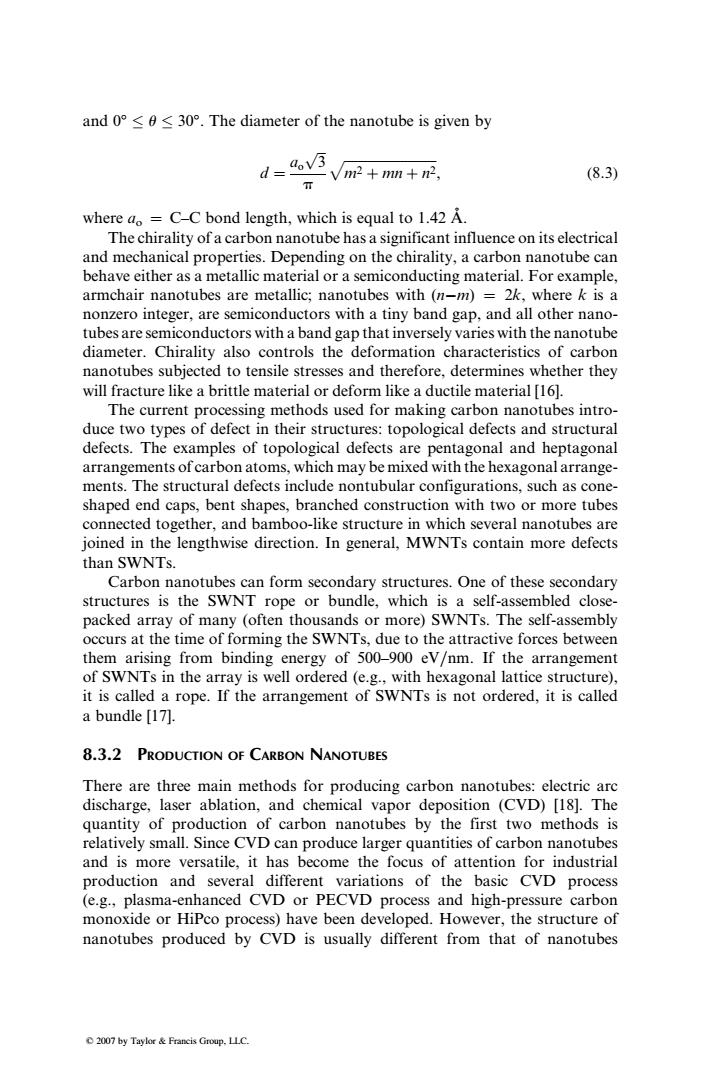正在加载图片...

andO°≤0≤30°.The diameter of the nanotube is given by d=。v3 -Vm2 +mn +n2, (8.3) T where ao C-C bond length,which is equal to 1.42 A The chirality of a carbon nanotube has a significant influence on its electrical and mechanical properties.Depending on the chirality,a carbon nanotube can behave either as a metallic material or a semiconducting material.For example, armchair nanotubes are metallic;nanotubes with (n-m)=2k,where k is a nonzero integer,are semiconductors with a tiny band gap,and all other nano- tubes are semiconductors with a band gap that inversely varies with the nanotube diameter.Chirality also controls the deformation characteristics of carbon nanotubes subjected to tensile stresses and therefore,determines whether they will fracture like a brittle material or deform like a ductile material [16]. The current processing methods used for making carbon nanotubes intro- duce two types of defect in their structures:topological defects and structural defects.The examples of topological defects are pentagonal and heptagonal arrangements of carbon atoms,which may be mixed with the hexagonal arrange- ments.The structural defects include nontubular configurations,such as cone- shaped end caps,bent shapes,branched construction with two or more tubes connected together,and bamboo-like structure in which several nanotubes are joined in the lengthwise direction.In general,MWNTs contain more defects than SWNTs. Carbon nanotubes can form secondary structures.One of these secondary structures is the SWNT rope or bundle,which is a self-assembled close- packed array of many (often thousands or more)SWNTs.The self-assembly occurs at the time of forming the SWNTs,due to the attractive forces between them arising from binding energy of 500-900 eV/nm.If the arrangement of SWNTs in the array is well ordered (e.g.,with hexagonal lattice structure), it is called a rope.If the arrangement of SWNTs is not ordered,it is called a bundle [17]. 8.3.2 PRODUCTION OF CARBON NANOTUBES There are three main methods for producing carbon nanotubes:electric arc discharge,laser ablation,and chemical vapor deposition (CVD)[18].The quantity of production of carbon nanotubes by the first two methods is relatively small.Since CVD can produce larger quantities of carbon nanotubes and is more versatile,it has become the focus of attention for industrial production and several different variations of the basic CVD process (e.g.,plasma-enhanced CVD or PECVD process and high-pressure carbon monoxide or HiPco process)have been developed.However,the structure of nanotubes produced by CVD is usually different from that of nanotubes 2007 by Taylor Francis Group.LLC.and 0 u 30. The diameter of the nanotube is given by d ¼ ao ffiffiffi 3 p p ffiffiffiffiffiffiffiffiffiffiffiffiffiffiffiffiffiffiffiffiffiffiffiffiffiffiffiffi m2 þ mn þ n2 p , (8:3) where ao ¼ C–C bond length, which is equal to 1.42 A˚ . The chirality of a carbon nanotube has a significant influence on its electrical and mechanical properties. Depending on the chirality, a carbon nanotube can behave either as a metallic material or a semiconducting material. For example, armchair nanotubes are metallic; nanotubes with (nm) ¼ 2k, where k is a nonzero integer, are semiconductors with a tiny band gap, and all other nanotubes are semiconductors with a band gap that inversely varies with the nanotube diameter. Chirality also controls the deformation characteristics of carbon nanotubes subjected to tensile stresses and therefore, determines whether they will fracture like a brittle material or deform like a ductile material [16]. The current processing methods used for making carbon nanotubes introduce two types of defect in their structures: topological defects and structural defects. The examples of topological defects are pentagonal and heptagonal arrangements of carbon atoms, which may be mixed with the hexagonal arrangements. The structural defects include nontubular configurations, such as coneshaped end caps, bent shapes, branched construction with two or more tubes connected together, and bamboo-like structure in which several nanotubes are joined in the lengthwise direction. In general, MWNTs contain more defects than SWNTs. Carbon nanotubes can form secondary structures. One of these secondary structures is the SWNT rope or bundle, which is a self-assembled closepacked array of many (often thousands or more) SWNTs. The self-assembly occurs at the time of forming the SWNTs, due to the attractive forces between them arising from binding energy of 500–900 eV=nm. If the arrangement of SWNTs in the array is well ordered (e.g., with hexagonal lattice structure), it is called a rope. If the arrangement of SWNTs is not ordered, it is called a bundle [17]. 8.3.2 PRODUCTION OF CARBON NANOTUBES There are three main methods for producing carbon nanotubes: electric arc discharge, laser ablation, and chemical vapor deposition (CVD) [18]. The quantity of production of carbon nanotubes by the first two methods is relatively small. Since CVD can produce larger quantities of carbon nanotubes and is more versatile, it has become the focus of attention for industrial production and several different variations of the basic CVD process (e.g., plasma-enhanced CVD or PECVD process and high-pressure carbon monoxide or HiPco process) have been developed. However, the structure of nanotubes produced by CVD is usually different from that of nanotubes 2007 by Taylor & Francis Group, LLC.���